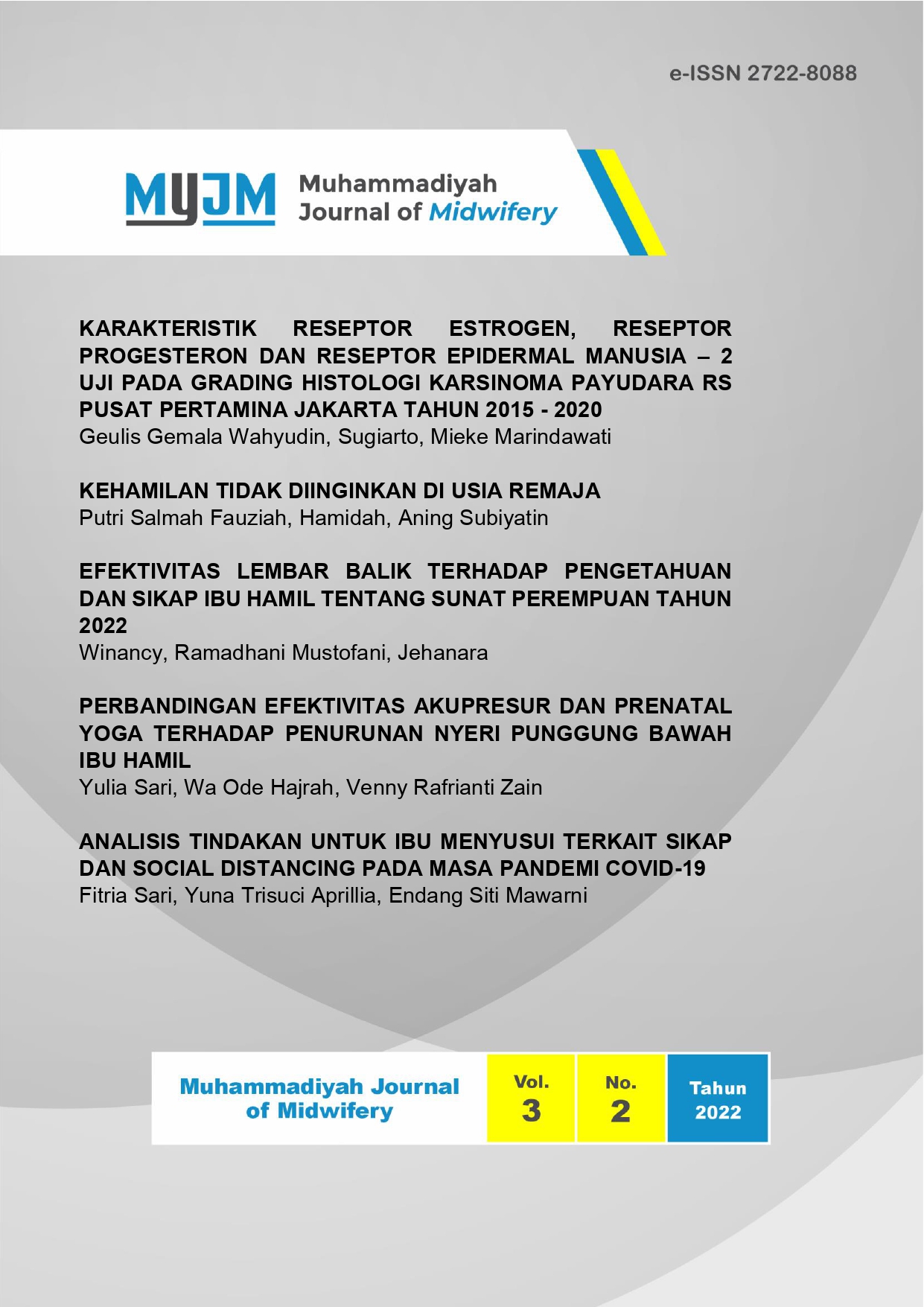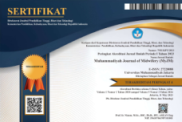Karakteristik Reseptor Estrogen, Reseptor Progesteron dan Reseptor Epidermal Manusia – 2 Uji pada Grading Histologi Karsinoma Payudara RS Pusat Pertamina Jakarta Tahun 2015 - 2020
DOI:
https://doi.org/10.24853/myjm.3.2.44-52Keywords:
derajat keganasan, ER, HER-2, histopatologi karsinoma payudara, PRAbstract
Latar belakang: Kanker wanita tertinggi di dunia adalah kanker payudara. Berdasarkan data Global Cancer Statistics (GLOBOCAN), pada tahun 2018 terdapat total 2.088.849 kasus. Sedangkan di Indonesia terdapat 58.256 kasus dengan total kematian 22.692 setiap tahun. Pemeriksaan histopatologi anatomi merupakan gold standard untuk mendiagnosis kanker payudara dan pemeriksaan imunohistokimia (IHK) dapat meningkatkan akurasi diagnosis. Standar pemeriksaan IHK untuk kanker payudara adalah Estrogen Receptor (ER), Progesterone Receptor (PR) dan ekspresi Human Epidermal Growth Factor Receptor 2 (HER-2). Metode: Penelitian ini merupakan penelitian deskriptif dengan menggunakan data sekunder berupa rekam medis. Penelitian dilakukan di RS Pusat Pertamina Jakarta pada bulan Oktober– Desember 2020, dengan total sampel sebanyak 164. Hasil: Hasil penelitian menunjukkan bahwa jenis karsinoma payudara terbanyak di RS Pusat Pertamina Jakarta adalah no special type dengan derajat keganasan III sebanyak 79 (61,7%) dari 164 dari total sampel. Subtipe yang paling molekuler adalah tipe luminal A. Pada wanita yang lebih tua, imunoekspresi yang paling sering ditemukan adalah ER positif, PR positif dan HER-2 negatif, yaitu luminal A. Simpulan: Dapat disimpulkan bahwa tipe histopatologi, derajat keganasan dan subtipe molekuler yang paling banyak ditemukan di RS Pusat Pertamina Jakarta adalah no special type, derajat keganasan III, dengan luminal molekular subtype A.References
Kumar V, Abbas AK, Aster JC, Klatt EC, Mitchell R, Fausto N, et al. Robbins Pathology Textbook 9th Edition. Elsevier/Saunders; 2015. (ClinicalKey 2012).
Observatory G. Breast Cancer. World Health Organization International Agency for Research on Cancer; 2019.
Kementerian Kesehatan Republik Indonesia. Pedoman Teknis Pengendalian Kanker Payduara & Kanker Leher Rahim. Jakarta: Direktorat Pengendalian Penyakit Tidak Menular; 2013.
Nigam M, Nigam B. Triple Assessment of Breast – Gold Standard in Mass Screening for Breast Cancer Diagnosis. IOSR J Dent Med Sci. 2013;7(3):1–7.
Suyatno, Pasaribu ET. Bedah Onkologi Diagnosis dan terapi. Jakarta: Sagung Seto; 2014.
Bhagat VM, Jha BM, Patel PR. Correlation of hormonal receptor and her-2/neu expression in breast cancer: a study at tertiary care hospital in South Gujarat. J Med Res. 2012;2:295–8.
Iwase H, Kurebayashi J, Tsuda H, Ohta T, Kurosumi M, Miyamoto K, et al. Clinicopathological analyses of triple negative breast cancer using surveillance data from the Registration Committee of the Japanese Breast Cancer Society. Breast Cancer. 2010 Apr;17(2):118–24.
Mitchell RN, Fausto N, Kumar V. Pocket companion to robbins & cotran pathologic basis of disease. 8th ed. Elsevier Saunders; 2011.
Hoda SA. Invasive ductal carcinoma: assessment of prognosis with morphologic and biologic markers. Basic Medical Key. 2016.
Khanna SP, Rigvardhan R. Correlation of histological grade with harmone receptors and her 2 neu in carcinoma breast - a tertiary centre study. Int J Contemp Med Res [IJCMR]. 2018;5(5):6–8.
Attanda A, Imam M, Umar A, Yusuf I, Bello S. Audit of nottingham system grades assigned to breast cancer cases in a Teaching Hospital. Ann Trop Pathol. 2017;(2).
Putra PKBS, Sumadi IWJ, Sriwidyani NP, Setiawan IB. Karakteristik klinikopatologik pasien kanker payudara dengan metastasis tulang di RSUP Sanglah pada tahun 2014 - 2018. e-CliniC. 2019 Dec;8(1).
Zangouri VMD, Akrami MMD, Tahmasebi SMD, Talei AMD, Ghaeini Hesarooeih AMD. Medullary breast carcinoma and invasive ductal carcinoma: a review study. Iran J Med Sci. 2018 Jul;43(4):365–71.
Jameel Z, Rosa M. Other carcinoma subtypes, WHO classified Invasive papillary [Internet]. Tozbikian G, Jorns JM, editors. PathologyOutlines.com; 2021. Available from: https://www.pathologyoutlines.com/topic/breastmalignantwhoclassification.html
Bae SY, Choi M-Y, Cho DH, Lee JE, Nam SJ, Yang J-H. Mucinous carcinoma of the breast in comparison with invasive ductal carcinoma: clinicopathologic characteristics and prognosis. J Breast Cancer. 2011 Dec;14(4):308–13.
Gao JJ, Swain SM. Luminal a breast cancer and molecular assays: a review. Oncologist. 2018 May;23(5):556–65.
Tsang JYS, Tse GM. Molecular Classification of Breast Cancer. Adv Anat Pathol. 2020 Jan;27(1):27–35.
Blows FM, Driver KE, Schmidt MK, Broeks A, van Leeuwen FE, Wesseling J, et al. Subtyping of breast cancer by immunohistochemistry to investigate a relationship between subtype and short and long term survival: a collaborative analysis of data for 10,159 cases from 12 studies. PLoS Med. 2010 May;7(5):e1000279.
Wiguna N, Manuaba I. Karakteristik pemeriksaan imunohistokimia pada pasien kanker payudara di rsup sanglah periode 2003-2012. Vol 3 No 7 (2014)E-Jurnal Med Udayana /. 2012;147:1–13.
Sun Y-S, Zhao Z, Yang Z-N, Xu F, Lu H-J, Zhu Z-Y, et al. Risk factors and preventions of breast cancer. Int J Biol Sci. 2017;13(11):1387–97.
AlZaman AS, Mughal SA, AlZaman YS, AlZaman ES. Correlation between hormone receptor status and age, and its prognostic implications in breast cancer patients in Bahrain. Saudi Med J. 2016 Jan;37(1):37–42.
Kalantari Khandani B, Tavakkoli L, Khanjani N. Metastasis and its Related Factors in Female Breast Cancer Patients in Kerman, Iran. Asian Pac J Cancer Prev. 2017 Jun;18(6):1567–71.
Downloads
Published
Issue
Section
License
(c) 2020 MyJM







